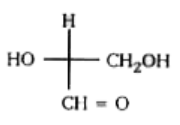D-Glyceraldehyde and L-Glyceraldehyde are C−2 epimers as well as enantiomers?
The correct Answer is:A
To determine whether D-Glyceraldehyde and L-Glyceraldehyde are C-2 epimers as well as enantiomers, we can follow these steps:
Step 1: Understand the Definitions
- Epimers: Epimers are sugars that differ in configuration at only one specific carbon atom (stereocenter).
- Enantiomers: Enantiomers are a pair of molecules that are non-superimposable mirror images of each other.
Step 2: Identify the Structure of D-Glyceraldehyde and L-Glyceraldehyde
- D-Glyceraldehyde has the hydroxyl group (OH) on the right side of the second carbon (C-2) when drawn in the Fischer projection.
- L-Glyceraldehyde has the hydroxyl group (OH) on the left side of the second carbon (C-2) when drawn in the Fischer projection.
Step 3: Analyze the Configuration
- In D-Glyceraldehyde, the configuration at C-2 is R (right).
- In L-Glyceraldehyde, the configuration at C-2 is S (left).
- Since they differ only at C-2, they are classified as epimers.
Step 4: Check for Enantiomerism
- D-Glyceraldehyde and L-Glyceraldehyde are mirror images of each other.
- Since they cannot be superimposed on one another, they are classified as enantiomers.
Conclusion
D-Glyceraldehyde and L-Glyceraldehyde are indeed C-2 epimers because they differ at the second carbon, and they are also enantiomers because they are non-superimposable mirror images of each other.
---
- Epimers: Epimers are sugars that differ in configuration at only one specific carbon atom (stereocenter).
- Enantiomers: Enantiomers are a pair of molecules that are non-superimposable mirror images of each other.
- D-Glyceraldehyde has the hydroxyl group (OH) on the right side of the second carbon (C-2) when drawn in the Fischer projection.
- L-Glyceraldehyde has the hydroxyl group (OH) on the left side of the second carbon (C-2) when drawn in the Fischer projection.
- In D-Glyceraldehyde, the configuration at C-2 is R (right).
- In L-Glyceraldehyde, the configuration at C-2 is S (left).
- Since they differ only at C-2, they are classified as epimers.
- D-Glyceraldehyde and L-Glyceraldehyde are mirror images of each other.
- Since they cannot be superimposed on one another, they are classified as enantiomers.
D-Glyceraldehyde and L-Glyceraldehyde are indeed C-2 epimers because they differ at the second carbon, and they are also enantiomers because they are non-superimposable mirror images of each other.
Topper's Solved these Questions
- BOOK - CENGAGE CHEMISTRY ENGLISHCHAPTER - BIOMOLECULESEXERCISE - Exercises (Single Correcttype)80videos
BIOMOLECULES
- BOOK - CENGAGE CHEMISTRY ENGLISHCHAPTER - BIOMOLECULESEXERCISE - Exercises (Assertion-Reasoning)15videos
BIOMOLECULES
- BOOK - CENGAGE CHEMISTRY ENGLISHCHAPTER - BIOMOLECULESEXERCISE - Exercises (Linked Comprehension)36videos
BIOMOLECULES
- BOOK - CENGAGE CHEMISTRY ENGLISHCHAPTER - AROMATIC COMPOUNDS AND ALKYL AND ARYL HALIDES EXERCISE - Archives Subjective Type4videos
AROMATIC COMPOUNDS AND ALKYL AND ARYL HALIDES
- BOOK - CENGAGE CHEMISTRY ENGLISHCHAPTER - CARBOXYLIC ACIDS AND THEIR DERIVATIVESEXERCISE - Exercises Archives (Analytical And Descriptive)34videos
CARBOXYLIC ACIDS AND THEIR DERIVATIVES
Similar Questions
Knowledge Check
- Question 1 - Select One
What is the structure of L-glyceraldehyde?
A B
B C
C DBoth (a) & (b)
DBoth (a) & (b) - Question 2 - Select One
Dihydroxyacetone-3 phosphate and glyceraldehyde-3-phosphate are interconvertible. The enzyme responsible for this interconversion belongs to the cateogry of
AisomerasesBligasesClyasesDhydrolases.
STATEMENT-1: D-Glucose and D-Mannose are C-2 epimers
and
STATEMENT-2 : They only have different configuration at carbon number-2.View SolutionOxidation of glyceraldehyde phosphate is accompanied by
View SolutionEnzyme aldolase which helps in spliiting 1,6 fructose biphosphate into dihydroxy acetone phosphate and glyceraldehyde phosphate belongs to the category of
View SolutionWhich of the following pairs are C−2 epimers?
View SolutionC3-epimer of D-Glucose is
View SolutionCalculate the number of ATP produced for one Glyceraldehyde 3-phosphate molecule by the end of aerobic respiration through Electron transport only
View Solution

